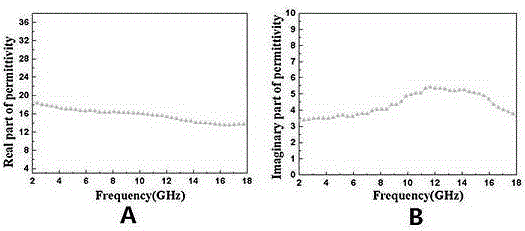Biology-base carbon nanofiber loaded cobalt ferrite wave-absorbing material and preparation method thereof
A nanofiber, bio-based carbon technology, applied in the field of materials, can solve the problems of high density, narrow frequency band, low performance, etc., and achieve the effects of uniform distribution, less environmental pollution, and improved wave absorbing performance
- Summary
- Abstract
- Description
- Claims
- Application Information
AI Technical Summary
Problems solved by technology
Method used
Image
Examples
Embodiment 1
[0030] 1. Preparation of lignocellulose nanofibers:
[0031] 10g of wood flour (50-70 mesh) was placed in a Soxhlet extractor, extracted with 450ml of phenylethanol solution with a volume ratio of 2:1 at 90°C for 6hrs, air-dried, transferred into a 600ml beaker, and added with 400ml of distilled water , 4.5g of sodium chlorite and 4ml of glacial acetic acid, mix well, heat to 75°C, and stir for 1hr. Then, 4ml of glacial acetic acid and 4.5g of sodium chlorite were added and heated in a magnetic heating stirrer at 75° C. for 1 hr, and this was repeated 5 times to remove lignin. The above mixture was incompletely filtered and washed with water until neutral to obtain a cellulose suspension. Dissolve 10g of potassium hydroxide into the above-mentioned cellulose suspension, raise the temperature to 90°C, keep it for 2hrs, filter and wash with water until neutral, and obtain a purified cellulose suspension. The above-mentioned purified cellulose suspension was ground 15 times at ...
Embodiment 2
[0038] 1. Preparation of lignocellulose nanofibers:
[0039] 10g of wood flour (50-70 mesh) was placed in a Soxhlet extractor, extracted with 450ml of phenylethanol solution with a volume ratio of 2:1 at 90°C for 6hrs, air-dried, transferred into a 600ml beaker, and added with 400ml of distilled water , 4.5g of sodium chlorite and 4ml of glacial acetic acid, mix well, heat to 75°C, and stir for 1hr. Then, 4ml of glacial acetic acid and 4.5g of sodium chlorite were added and heated in a magnetic heating stirrer at 75° C. for 1 hr, and this was repeated 5 times to remove lignin. The above mixture was incompletely filtered and washed with water until neutral to obtain a cellulose suspension. Dissolve 10g of potassium hydroxide into the above-mentioned cellulose suspension, raise the temperature to 90°C, keep it for 2hrs, filter and wash with water until neutral, and obtain a purified cellulose suspension. The above-mentioned purified cellulose suspension was ground 15 times at ...
Embodiment 3
[0045] 1. Preparation of lignocellulose nanofibers:
[0046] 10g of wood flour (50-70 mesh) was placed in a Soxhlet extractor, extracted with 450ml of phenylethanol solution with a volume ratio of 2:1 at 90°C for 6hrs, air-dried, transferred into a 600ml beaker, and added with 400ml of distilled water , 4.5g of sodium chlorite and 4ml of glacial acetic acid, mix well, heat to 75°C, and stir for 1hr. Then, 4ml of glacial acetic acid and 4.5g of sodium chlorite were added and heated in a magnetic heating stirrer at 75° C. for 1 hr, and this was repeated 5 times to remove lignin. The above mixture was incompletely filtered and washed with water until neutral to obtain a cellulose suspension. Dissolve 10g of potassium hydroxide into the above-mentioned cellulose suspension, raise the temperature to 90°C, keep it for 2hrs, filter and wash with water until neutral, and obtain a purified cellulose suspension. The above-mentioned purified cellulose suspension was ground 15 times at ...
PUM
 Login to view more
Login to view more Abstract
Description
Claims
Application Information
 Login to view more
Login to view more - R&D Engineer
- R&D Manager
- IP Professional
- Industry Leading Data Capabilities
- Powerful AI technology
- Patent DNA Extraction
Browse by: Latest US Patents, China's latest patents, Technical Efficacy Thesaurus, Application Domain, Technology Topic.
© 2024 PatSnap. All rights reserved.Legal|Privacy policy|Modern Slavery Act Transparency Statement|Sitemap


